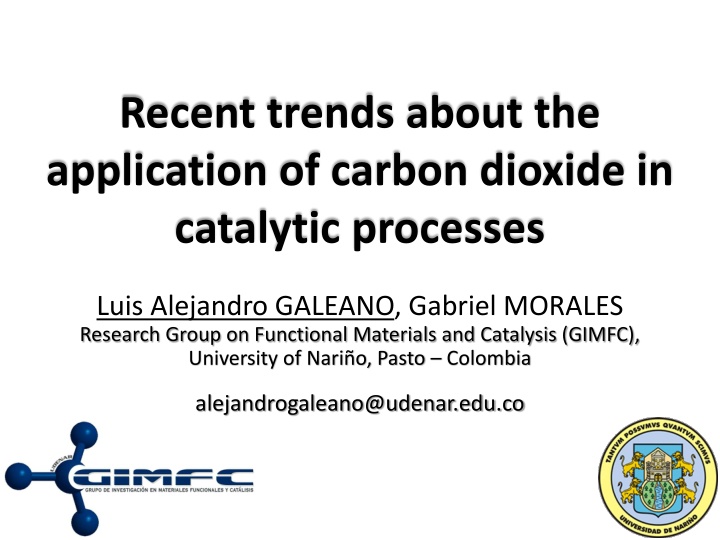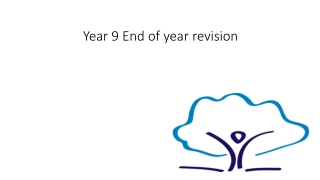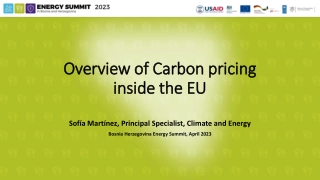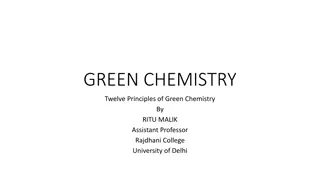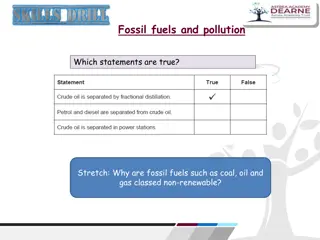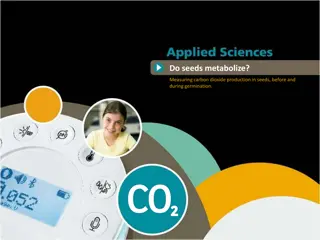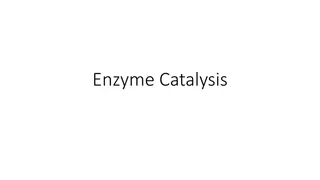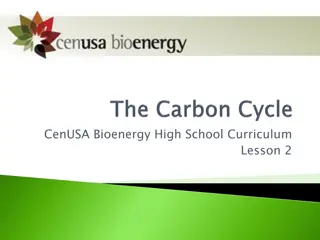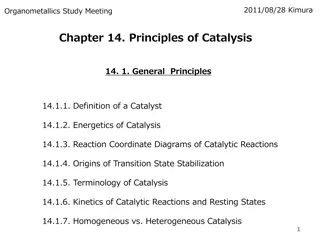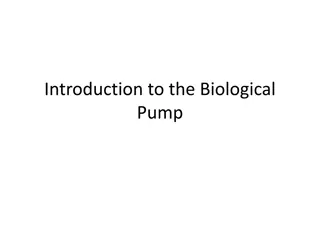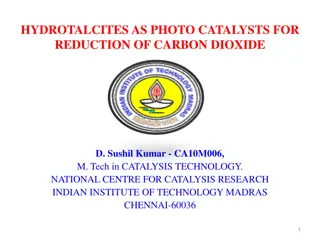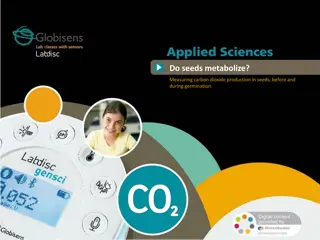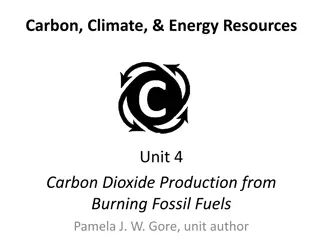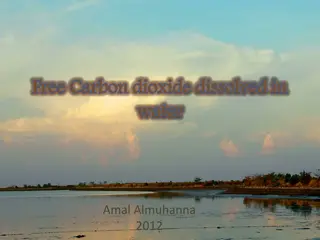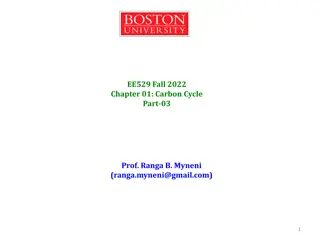Recent Trends in Carbon Dioxide Applications for Catalysis
This study explores recent trends in utilizing carbon dioxide in catalytic processes, focusing on its applications, characteristics, structural properties, and advantages as a solvent. The research delves into the use of CO2 as a reagent, solvent, and for synthesis of catalysts, highlighting both its benefits and challenges in catalyzed reactions.
Download Presentation

Please find below an Image/Link to download the presentation.
The content on the website is provided AS IS for your information and personal use only. It may not be sold, licensed, or shared on other websites without obtaining consent from the author.If you encounter any issues during the download, it is possible that the publisher has removed the file from their server.
You are allowed to download the files provided on this website for personal or commercial use, subject to the condition that they are used lawfully. All files are the property of their respective owners.
The content on the website is provided AS IS for your information and personal use only. It may not be sold, licensed, or shared on other websites without obtaining consent from the author.
E N D
Presentation Transcript
Recent trends about the application of carbon dioxide in catalytic processes Luis Alejandro GALEANO, Gabriel MORALES Research Group on Functional Materials and Catalysis (GIMFC), University of Nari o, Pasto Colombia alejandrogaleano@udenar.edu.co
Climate change and CO2emissions ~ 390 ppm (in 2011) (1) Global greenhouse gas emission sources in 2004 (2) 77% Industrial Revolution (1) H. Gitay, A. Su rez, R.T. Watson. Climate change and biodiversity. Intergovernmental Panel on Climate Change. 2002 p. 4 (2) K. Sumida, D. L. Rogow, J. A. Mason, T. M. McDonald, E. D. Bloch, Z. R. Herm, T.-H. Bae, J. R. Long. Chem. Rev. 112 (2012) 724. 2
Chemical methods Physical methods MOF-5 : Zn4O(BDC)3 CO2 capture CO2 storage Industrial uses CO2emissions Raw material Products Process Fuels (carbon, gas, biomass) (3) K. Sumida, D. L. Rogow, J. A. Mason, T. M. McDonald, E. D. Bloch, Z. R. Herm, T.-H. Bae, J. R. Long. Chem. Rev. 112 (2012) 724. 3
Characteristics of CO2 Physicochemical properties (4) (5) (4) C.M. Rayner,. Org. Process. Res. Dev. 11 (2007) 121. (5) P.G. Jessop, T. Ikariya, R. Noyori, Chem Rev. 99 (1999) 475. 4
Characteristics of CO2 Structural Possible coordination modes on a transition metal center (6) Non-toxic (TLV 5,000 ppms) Non- flammable Environmental safe Low critical temperature Abundant and cheap Green features of scCO2(7) (6) X. Yin, J. R. Moss. Coord. Chem. Rev. 181 (1999) 27. (7) E. J. Beckman. J. Supercrit. Fluids. 28 (2004) 121. 5
Applications of CO2 in catalysis Reagent in catalyzed reactions Solvent of catalytic reactions Solvent for synthesis of catalysts 6
CO2as a solvent of catalyzed reactions Advantages: Tunable density Non-polar solvent May replace organic solvents (CH2Cl2, toluene, methanol, ether, ) Difficulties: Weak solvent Lewis acid Insolubility of the catalysts Reaction/separation strategies for multi-phase catalysis in scCO2 (8) (8) S. Pitter, E. Dinjus, C. Ionescu, C. Maniut, P. Makarczyk, F. Patcas. Top. Organomet. Chem. 23 (2008) 109. (9) G. Jessop. J. Supercrit. Fluids. 38 (2006) 211. 7
CO2as a solvent Solubility of homogeneous catalysts in scCO2 Carbonyl ligands CO2-philic Ligands Highly fluorinated ligands Metal complexes Trialkylphosphines Trialkylphosphites Typical CO2- insoluble Ligands Add CO2-philic substituents in meta or para positions of aromatic rings Add co-solvents or surfactants Switch to more soluble phosphines, as trialkylphosphines Alternative strategies Aromatic Triphenyl phosphines Chiral ligands 8 (13) G. Jessop. J. Supercrit. Fluids. 38 (2006) 211.
CO2as a solvent Homogeneous catalysts in scCO2 could be recovered by Lowering P to precipitate the catalyst from the SCF (CESS method) Cooling the SCF until the catalyst precipitates Using catalysts essentially insoluble in scCO2(especially if the reaction is performed in a SCF other than CO2but the separation is performed with scCO2) Using a membrane allowing the SCF and the products to pass through but not the catalyst. Releasing entirely the scCO2and extracting the fluorinated catalyst from the organic product with a fluorous solvent Self-separation of a product insoluble in the scCO2 Dissolution of the catalyst in a liquid immiscible with the SCF (i.e. biphasic catalysis) (water, ionic liquid, a liquid polymer, or ethylene glycol). Using an inverted biphasic system in which the catalyst preferentially partitions into the scCO2while the product preferentially partitions into a liquid immiscible with the scCO2. Attaching the catalyst to a solid support (immobilization) 9
CO2as a solvent 1-Octene hydrogenation P(H2) (MPa) Total conv. (%) Products (% conv.) Solvent T (K) t (h) TON TOF n-octane (24.6) 2-octene (43.0) 3-octene (16.2) scCO2 353 1.0 1.5 83.8 341 227 n-octane (19.1) 2-octene (56.0) 3-octene (22.9) Toluene 353 1.0 5 98 328 66 n-octane (5.40) 2-octene (23.9) 3-octene (11.1) Methanol 353 1.0 5 40.4 137 27 P(CO2) = 10.2 MPa 10 10. F. Y lmaz, A. Mutlu, H. nver, M. Kurt a, I. Kani. J. Supercrit. Fluids. 54 (2010) 202
CO2as a solvent 1-Octene hydroformylation L : tris(3,5-bis(trifluoromethyl)phenyl)phosphine P(H2) (MPa) Selectivity (%) TOF T (K) t (h) (molaldmolRh-1h-1) 343 39.9 1.5 98.8 7170 (11) A. C. J. Koeken, S. J. M. Bakker, H. M. Costerus, L. J. P. Broeke, B.-J. Deelman, J. T. F. Keurentjes. J. Supercrit. Fluids. 46 (2008)47. 11
CO2as a solvent Epoxidation Substrate Catalyst (mol %) PhIO (eq) Yield (%) % ee Styrene 5 2 66 21 (R) Styrene 5 4 100 21 (R) Cis- -methylstyrene 5 4 100 47 (R, S) Cis- -methylstyrene 10 4 60 47 (R, S) P(CO2) = 250 bar; T = 35 C. (12) C. Gao, W. Shin, J. Han, D. Han, M. A. Chari, H. Kim, K.-H. Ahn. Bull. Korean. Chem. Soc. 30 (2009) 541. 12
CO2as a solvent Examples of catalyzed reactions in scCO2 Reaction Substrate Product Catalyst CH2= CH2 Hydroformylation RCHO Ru3(CO)12 PhCH=CHCHO PhCH=CHCH2OH Hydrogenation RuCl3/[(C6F5)PCH2]2 Oxidation FeCl(tpfpp) Hydroxylation Mn(salen)Cl Polymerization Ethylene Polyethylene Pd complexes Tpfpp = 5,10,15,20- tetrakis(pentafluorophenyl)porphyrin 13 (13) G. Jessop. J. Supercrit. Fluids. 38 (2006) 211.
CO2as a solvent Examples of catalyzed reactions in scCO2 Reaction Substrate Product Catalyst Carbonylation CH4/ CO / h CH3CHO RhCl(PMe3)3 Cyclization RC CR PdCl2/ CuCl2 Diels-Alder AlCl3 Epoxidation Mo(CO)6 14 (13) G. Jessop. J. Supercrit. Fluids. 38 (2006) 211.
CO2as a solvent Important catalyzed reactions still not sufficiently studied in scCO2 Reaction Substrate General Reasons Carbonylation ROHs or R-X (X= halogen) - Solutions of very toxic species in SCF are included. Use of very specialized facilities is then mandatory. As P rapidly rises vs. T in SCF, exothermic reactions would represent significant risk of explosion! Carbonylation R-NO2 (R = aromatic) - Hydrocyanation Olefins - Hydrogenation CO Hydrogenation Arenes Chlorination Olefins 15 (13) G. Jessop. J. Supercrit. Fluids. 38 (2006) 211.
CO2as a solvent Electrocatalysts in scCO2 Wet impregnation Co-precipitation Deposition-precipitation Sol-gel Microemulsions Chemical vapor impregnation Traditional routes for preparation of supported metal nanoparticles Alternative solution Disadvantage or limitations by poor . Control on the nanoparticle s size Control metal distribution Metal loading No easily applied to polymers or aerogels Supercritical Deposition (SCD) 16 (15) S. E. Bozbag, C. Erkey. J. Supercrit. Fluids. 62 (2012) 1.
CO2as a solvent Schematic representation of the sequential supercritical deposition 17 (15) S. E. Bozbag, C. Erkey. J. Supercrit. Fluids. 62 (2012) 1.
CO2as a solvent Example of the supercritical deposition 0 MPa 8 MPa 16 MPa CO2 H2 / CO2 Depressurize CNT CNT, Pt(acac)2 MeOH Pt(acac)2 MeOH Pt-CNT 15 min 1 hour ~293 K 473 K 473 K Application TEM image of CNT decorated by platinum nanoparticlessynthesized in scCO2 (25% Pt-CNT, 0.07 mg/cm2) 18 (16) Y. Lin, X. Cui, C. Yen, C. M. Wai. J. Phys. Chem. B. 109 (2005) 14410.
CO2as a reagent Advantages Cheap raw material Replace toxic reagents (Phosgene, carbon monoxide, ) General drawback High stability low reactivity Oxidized low-energy synthetic targets high-energy starting materials Shifting the equilibrium to the product side by removing a particular compound Supplying physical energy such as light or electricity 19 (17) T. Sakakura, J. C. Choi, H. Yasuda. Chem. Rev. 107 (2007) 2365.
CO2as a reagent Currently useful processes Fertilizers Intermediate in the pharmaceutical industry, polymers and cosmetics Biodegradable polymers Analgesic and antipyretic Chemical reagent H2storage 20 (17) T. Sakakura, J. C. Choi, H. Yasuda. Chem. Rev. 107 (2007) 2365 .
CO2as a reagent Cycloaddition on epoxides Reaction conditions Solvent P(CO2)(MPa) Catalyst Epoxide Selectivity (%) Yield (%) T(K) t (h) ZnO PO DMF 8.0 423 15 92.6 8.7 Mg- Al oxide PO TBAB 0.5 393 24 91.7 88.0 Cs-P-Si oxide PO ---- 8.0 473 8 96.0 94.0 Cr-salen-SiO2 SO CH2Cl2 10.0 353 6 100 74.0 Mn-salen-SiO2 SO ---- 3.5 413 3 --- 96 N-methyl imidazol Al-salen-PEA SO 10.0 353 6 87.6 78 BMImBF4/SiO2 Au- ion exchange resin PO ---- 8.0 433 4 >99 96 PO ---- 3.0 423 10 --- 89.5 PO = propylene oxide, SO = styrene oxide, TBAB : Tetrabutyl ammonium bromide (co-catalyst), PEA = poly(ethylene glycol bismethacrylate); BMImBF4= 3-n-butyl-1-methyl-imidazolium tetrafluoborate 21 (18) W. L. Dai, S.-L. Luo, S.-F. Yin, C.-T. Au. Appl. Catal. A: Gen. 366 (2009) 2.
CO2as a reagent Cycloaddition on epoxides Mechanism of the catalytic cycle for the Mn-(salen)Br complex 22 (19) F. Jutz, J.-D. Grunwaldt, A. Baiker. J. Mol. Catal. A: Chem. 297 (2009) 63.
CO2as a reagent Direct synthesis of styrene carbonate catalyzed by [Mn-salenX] complexes Epoxidation Coupling to CO2 Direct synthesis of cyclic organic carbonates * Optimal molar ratio epoxide:CO2(1:4) (19) 23 (19) F. Jutz, J.-D. Grunwaldt, A. Baiker. J. Mol. Catal. A: Chem. 279 (2008) 94.
CO2as a reagent Direct synthesis of styrene carbonate catalyzed by [Mn-salenX] complexes Selectivity (%) Styrene Conversion (%) Complex B PMK BA SE PED Others Hydrogen peroxide at 30 wt.% [Mn(salen)Cl] 15.0 52.1 1.8 5.3 14.5 18.9 7.4 + [Mn(salen)Br] 3.0 73.0 2.0 3.0 2.0 0.0 20.0 [Mn(salen)I] 2.5 90.0 2.8 4.0 0.0 0.0 3.2 - Iodosylbenzene in CH2Cl2 9.0 66.1 [Mn(salen)Cl] 4.7 0.0 16.7 0.0 12.6 Cl - Br - I + Epoxidation - [Mn(salen)Br] 7.1 69.4 0.0 0.0 4.2 0.0 26.3 [Mn(salen)I] 5.7 71.2 0.0 0.0 2.5 0.0 26.3 - Coupling + B = Benzaldehyde; PMK = Phenyl methyl ketone; BA = Benzoic acid; SE = Styrene epoxide, PED = 1-Phenyl-1,2-ethanediol; and Others = Styrene polymers (dimers and trimers). 24
CO2as a reagent Direct synthesis of styrene carbonate catalyzed by other systems Oxidizing agent Catalyst P(CO2)(MPa) T (K) t (h) Yield (%) TBAB TBHP 15 273 6 33 * MTO / Zn[EMIm]2Br4/ [BMIm]BF4 Au/R2O1 UHP 0 4 303 353 2 2 83 TBHP 0 4 273 423 3 4 51 * Multi-step process; TBAB = tetrabutyl ammonium bromide, TBHP = tert-butyl hydroperoxide; BMIm = 1-butyl-3-methylimidazolium; EMIm = 1-ethyl-3-methylimidazolium; UHP = Urea hydroperoxide; R2O1 = Amberlite IRA-400 modified (20) J. Sun, S.-I. Fujita, B. M. Bhanage, M. Arai. Catal. Commun. 5 (2004) 83. (21) F. Ono, K. Qiao, D. Tomida, C. Yokoyama. Appl. Catal. A: Gen. 333 (2007) 107. (22) D. Xiang, X. Liu, J. Sun, F.-S. Xiao, J. Sun, Catal. Today. 148 (2009) 383. 25
CO2as a reagent Proposed mechanism for direct synthesis of styrene carbonate catalyzed over Au/R2O1 (22) 26 (22) D. Xiang, X. Liu, J. Sun, F.-S. Xiao, J. Sun, Catal. Today. 148 (2009) 383.
CO2as a reagent Glycerol valorization Catalyst T (K) P(CO2) (MPa) Yield (%) n-Bu2SnO n-Bu2SnO n-Bu2SnO 353 13.8 25 393 3.5 22 393 13.8 30 27 (25) J. George, Y. Patel, M. Pillai, P. Munshi. J. Mol. Catal. A: Chem. 304 (2009) 1.
CO2as a reagent CO2-copolymerization 72.5 Kg mol-1 Yield (%) Selectivity (%) P(CO2)(MPa) / T (K) t (h) TOF 2 / 313 0.5 14.2 290 98 2 / 313 1.0 27.2 275 99 2 / 313 1.5 37.5 250 >99 2 / 313 2.0 46.8 234 >99 28 (26) H. Li, Y. Niu,. React. Funct. Polym. 71 (2011) 121.
CO2as a reagent Hydroformylation with CO2 Reaction condition: 4 mmol 1-hexene, 0.2 mmol catalyst, PCO2: 2.5 Mpa, PH2: 2.5 Mpa, 423 K, 17 hours Promoter (mmol) Solvent Alcohols (%) Aldehydes (%) Hexane (%) LiCl (0.09) Toluene/NMP --- --- 100 LiCl (0.75) Toluene/NMP 55 9 36 LiCl (0.75) DMF 65 --- 30 LiCl (0.75) NMP 55 9 36 [BMIM]Cl (0.75) NMP 60 --- 40 NMP : 1-methyl-2-pyrrolidone, DMF : dimethylformamide, [BMIM]Cl : 1-butyl-3-methylimidazolium chloride (31) M.-L. Kontkanen, L. Oresmaa, M. A. Moreno, J. J nis, E. Laurila, M. Haukka. Appl. Catal. A: Gen. 365 (2009) 130 . 29
Concluding remarks CO2capture and storage: Development of novel and efficient materials is determinant. CO2as a solvent: Improved immobilization of active metal complexes on solid supports is required. One of the more interesting applications of scCO2is in the preparation of metal nanoparticles by SCD. CO2as a reagent: A close compromise between active sites may enable more efficient one-pot production of cyclic carbonates from olefines, by using scCO2playing a simultaneous role of solvent and reagent. 30
